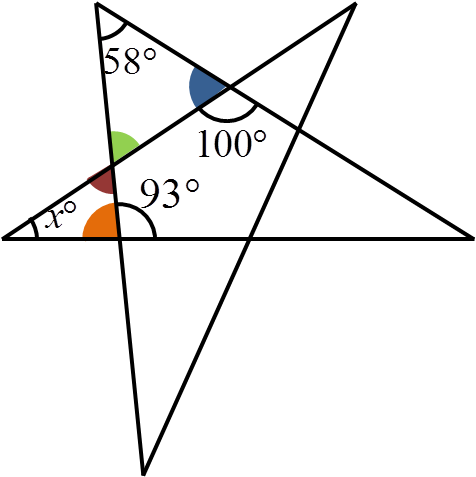Skip over navigation
There are two different ways of calculating the angle $x$.
 The first method is as follows:
The first method is as follows:
The blue angle can be calculated since angles on a straight line add to $180^\circ$. This means it is $180^\circ - 100^\circ = 80^\circ$.
The orange angle can be calculated similarly, to be $180^\circ - 93^\circ = 87^\circ$.
The green angle can then be calculated since the angles in the top-left triangle add up to $180^\circ$. This is $180^\circ - 80^\circ - 58^\circ = 42^\circ$.
The green and red angles are opposite angles. This means that they are equal, so the red angle is also $42^\circ$.
Then, the angles in the left-hand triangle must add up to $180^\circ$, so $x^\circ = 180^\circ - 42^\circ - 87^\circ= 51^\circ$.
 The other method involves looking at the farthest right angle in the diagram.
The other method involves looking at the farthest right angle in the diagram.
The angles in the red and purple triangle must add up to $180^\circ$, so the green angle is $180^\circ - 58^\circ - 93^\circ = 29^\circ$.
Then, the angles in the blue triangle must also add up to $180^\circ$. Therefore, $x^\circ = 180^\circ - 29^\circ - 100^\circ = 51^\circ$.


Or search by topic
Number and algebra
Geometry and measure
Probability and statistics
Working mathematically
Advanced mathematics
For younger learners
Angle Please
Age 11 to 14
ShortChallenge Level 





- Problem
- Solutions
There are two different ways of calculating the angle $x$.
 The first method is as follows:
The first method is as follows:The blue angle can be calculated since angles on a straight line add to $180^\circ$. This means it is $180^\circ - 100^\circ = 80^\circ$.
The orange angle can be calculated similarly, to be $180^\circ - 93^\circ = 87^\circ$.
The green angle can then be calculated since the angles in the top-left triangle add up to $180^\circ$. This is $180^\circ - 80^\circ - 58^\circ = 42^\circ$.
The green and red angles are opposite angles. This means that they are equal, so the red angle is also $42^\circ$.
Then, the angles in the left-hand triangle must add up to $180^\circ$, so $x^\circ = 180^\circ - 42^\circ - 87^\circ= 51^\circ$.
 The other method involves looking at the farthest right angle in the diagram.
The other method involves looking at the farthest right angle in the diagram.The angles in the red and purple triangle must add up to $180^\circ$, so the green angle is $180^\circ - 58^\circ - 93^\circ = 29^\circ$.
Then, the angles in the blue triangle must also add up to $180^\circ$. Therefore, $x^\circ = 180^\circ - 29^\circ - 100^\circ = 51^\circ$.
This problem is taken from the UKMT Mathematical Challenges.
You can find more short problems, arranged by curriculum topic, in our short problems collection.
You may also like
Consecutive Numbers
An investigation involving adding and subtracting sets of consecutive numbers. Lots to find out, lots to explore.
Days and Dates
Investigate how you can work out what day of the week your birthday will be on next year, and the year after...

